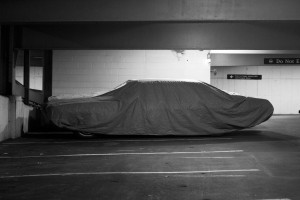
Under the cover of darkness, we drive into the Pierson-Sage parking garage, just north of Yale’s Science Hill. It is nighttime in mid-March. Two recent graduates, now Yale employees, promise a juicy story. I can’t help but think of the scene in “All the President’s Men” when Bob Woodward coaxes the Watergate story out of an informant in a parking garage in Washington, D.C. But our target that night is not a national scandal (though I still kept my hopes up); it is an unlikely fleet of abandoned cars.
“Welcome to the graveyard of elephants,” one of the Yale employees says as we descended into the bowels of the garage. We creep up on a handful of tarp-covered cars, vaguely resembling sleeping pachyderms. Upon closer inspection, three or four of the cars appear luxurious enough to belong in someone’s private collection. One stands out from the crowd.
The 1965 Dodge is so old that it has sliders instead of knobs for the car radio. I worry that I will find a body inside, but instead I find a rusty paint scraper and a pair of shoelaces. The stuffing explodes out of the back seat, but I cannot locate the animal that has been gnawing on the fabric. The odometer reads 67,256, and a 1994 New York emissions test sticker indicates the exact same mileage. Either the odometer is broken or this car was moved from New York to Yale’s Pierson-Sage garage two decades ago.
The New York State Department of Motor Vehicles doesn’t help, but not for lack of trying. A license plate search returned no registration or inspection records — records are deleted after ten years of no activity, according to Pete Bucci, the department’s public information officer. The decaying sticker provides the only evidence of this car’s strange journey.
While nobody — except one intrepid journalist — seems to have been thinking about this car in over a decade, parking lot patrons are taking note of other abandoned cars. On the top level of the garage sits an old pickup truck. Its flat tires hint that it hasn’t been driven in a while, but that hasn’t stopped people from using it — as a trash dump. Garbage litters the Chevy’s bed. Broken windshield wipers poke through a layer of plastic bottles, coffee cups, and rusty hubcaps. I can’t find the shredded documents; maybe they have already decomposed.
Someone has stuck a note underneath the windshield wiper that reads, “Is this truck for sale? If so, let me know.” I give Bill, the man who left the note, a call. He says that he noticed the pickup in July 2013, because his son has an identical one that needed some spare parts. Now, at the end of August, he hasn’t received a call back. When I return to the garage, the note is gone, but the truck remains.
It’s unclear why the truck hasn’t been removed. The Chevy’s last visible Yale parking permit expired on May 28, 2012. Another five vehicles appear similarly abandoned in the garage. Some of the cars I found did not have any sort of permit altogether, and others had permits that expired years ago.
Ed Bebyn, Yale’s director of parking and transit, writes in an email that “essentially, these cars are permitted vehicles.” That is to say: Cars that are parking in the garage are required to have permits, so if a car is parking in the garage, it must have a permit. There are always some abuses, he adds, but a new sticker program to be implemented this fall should make the few offenders comply. Karen Peart, a press officer at the Office of Public Affairs, explained that only cars in open Yale lots are currently required to have stickers; Pierson-Sage is not an open lot, but rather a garage. The new program would extend the sticker requirement to Yale’s garages starting on Sept. 2. However, she declined a phone interview, so I never received an answer about what would happen to these abandoned cars. If the New York DMV can’t even find a record of the ’65 Dodge, I doubt Yale can.
In his email, Bebyn said that some of the dust-covered cars belong to students who buy long-term parking and just keep the cars in the garage. Some cars thus only appear to be abandoned. No conspiracy there. But others have tires that look like they have not functioned in years, and their windshields do not display valid parking permits. One has to wonder whether someone is really paying Yale nearly a hundred dollars a month to store his or her junk. The persistent, suspicious presence of these cards indicates they are low on the list of the priorities of the parking administration.
Some people who pass through the garage are taking justice into their own hands — more accurately, their own fingers. Some have wiped messages into the grime covering a few of the cars. The front window of a red Metro Geo: “DANG WASH ME PLZ.” Someone has drawn a frown, nose, and eyebrows on the hood. But nobody has taken up the task set forth by the anonymous complainant.
When I leave the parking garage with the employees that cold night in March, I am still searching for a story. But sometimes a garage full of cars really is just a garage full of cars. There are no secret documents here — except, perhaps, those related to the new sticker policy. This story is full of actors who go half way: laypeople interested enough to demand cleanup but lazy enough only to scratch off enough dust to leave their message, and a parking office interested enough to promise amorphous change but stubborn enough to not explain it.
Not all mysterious parking lots will bring down the presidency.
Ike Swetlitz is a senior in Silliman College. He is the executive editor of the New Journal.

